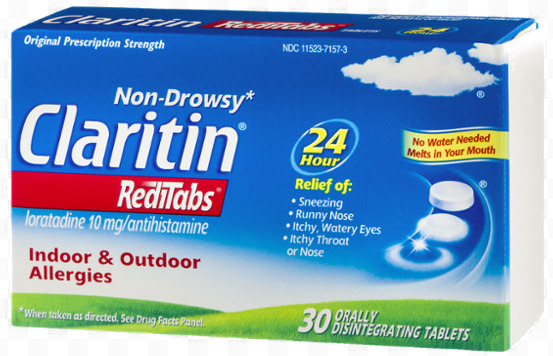(2.31)
Based on 10 studies
| Side Effect | Affected |
|---|---|
| somnolence/sedation |

Image for illustration purposes only. Actual medication may appear different.
Buy Claritin
No Prescription Needed

Image for illustration purposes only. Actual medication may appear different.
Highlights
- Reduces day and night itching
- >50% of patients respond positively
- Less drowsiness than other antihistamines (5% vs 40%)
- Mild drowsiness in small number of patients
- Safe to use with other treatments like topical steroids
Loratadine can help reduce itching (pruritus) in people with atopic dermatitis, both during the day and night. More than half of patients showed positive response to the treatment.
| Study Summary | Study Type | Studied Population | Results |
|---|---|---|---|
|
📄
Loratadine significantly reduced itching (pruritus) in patients with atopic dermatitis compared to placebo, both during day and night. At least 9 out of 16 patients responded positively to the treatment.
|
Clinical Trial |
Total Patients: 16
|
Majority of patients (at least 56%) responded positively to loratadine treatment |
|
📄
Loratadine was found to be as effective as hydroxyzine in treating atopic dermatitis symptoms, reducing symptoms by 57%. Importantly, loratadine caused much less drowsiness than hydroxyzine, with only one patient reporting sleepiness compared to eight patients on hydroxyzine.
|
Clinical Trial |
Total Patients: 41
Severity: not available Age: 18-65
|
Loratadine showed better symptom reduction than both hydroxyzine and placebo |
Loratadine significantly reduced itching (pruritus) in patients with atopic dermatitis compared to placebo, both during day and night. At least 9 out of 16 patients responded positively to the treatment.
Therapeutic effect of loratadine on pruritus in patients with atopic dermatitis. A multi-crossover-designed studyLoratadine was found to be as effective as hydroxyzine in treating atopic dermatitis symptoms, reducing symptoms by 57%. Importantly, loratadine caused much less drowsiness than hydroxyzine, with only one patient reporting sleepiness compared to eight patients on hydroxyzine.
Relative efficacy and safety of loratadine, hydroxyzine, and placebo in chronic idiopathic urticaria and atopic dermatitisLoratadine is as effective as hydroxyzine (another antihistamine) for treating symptoms, but causes much less drowsiness. Only 5% of patients on loratadine reported feeling sleepy compared to 40% of those taking hydroxyzine.
| Study Summary | Study Type | Studied Population | Results |
|---|---|---|---|
|
📄
Loratadine was found to be as effective as hydroxyzine in treating atopic dermatitis symptoms, reducing symptoms by 57%. Importantly, loratadine caused much less drowsiness than hydroxyzine, with only one patient reporting sleepiness compared to eight patients on hydroxyzine.
|
Clinical Trial |
Total Patients: 41
Severity: not available Age: 18-65
|
Loratadine showed better symptom reduction than both hydroxyzine and placebo |
Loratadine was found to be as effective as hydroxyzine in treating atopic dermatitis symptoms, reducing symptoms by 57%. Importantly, loratadine caused much less drowsiness than hydroxyzine, with only one patient reporting sleepiness compared to eight patients on hydroxyzine.
Relative efficacy and safety of loratadine, hydroxyzine, and placebo in chronic idiopathic urticaria and atopic dermatitisWhen used alongside strong topical steroids (like mometasone cream), loratadine may not provide additional benefits, though it remains safe to use with no serious side effects.
| Study Summary | Study Type | Studied Population | Results |
|---|---|---|---|
|
📄
The study found that adding loratadine (an antihistamine) to mometasone cream treatment did not provide additional benefits for children with atopic dermatitis. The mometasone cream alone was very effective in treating the condition.
|
Clinical Trial |
Total Patients: 48
Severity: not available Age: mean age 73.67 months (approximately 6 years)
|
Both groups showed significant improvement, with no difference between loratadine and placebo groups (p = 0.99) |
The study found that adding loratadine (an antihistamine) to mometasone cream treatment did not provide additional benefits for children with atopic dermatitis. The mometasone cream alone was very effective in treating the condition.
Therapeutic efficacy and safety of loratadine syrup in childhood atopic dermatitis treated with mometasone furoate 0.1 per cent creamA newer version of loratadine (desloratadine) combined with other medications may be effective for treating eczema and reducing inflammation.
| Study Summary | Study Type | Studied Population | Results |
|---|---|---|---|
|
📄
The combination of desloratadine citrate and compound glycyrrhizin was more effective in treating subacute eczema compared to compound glycyrrhizin alone. The combination therapy showed lower inflammation markers and fewer side effects.
|
Randomized Controlled Trial |
Total Patients: 100
Severity: subacute Age: not available
|
The combination therapy was more effective in reducing inflammation |
The combination of desloratadine citrate and compound glycyrrhizin was more effective in treating subacute eczema compared to compound glycyrrhizin alone. The combination therapy showed lower inflammation markers and fewer side effects.
Desloratadine citrate combined with compound glycyrrhizin in the treatment of subacute eczema: A randomized trialIs Claritin Right For Me?
-
You are 6 years or older
-
You have allergy symptoms like runny nose, itchy eyes, or sneezing
-
You need relief from itching related to atopic dermatitis
Interested in eczema products?
As a member of the Lemma Health community, you'll stay up to date with research, hear about new products, and get exclusive access to discounts.
How Lemma Health Works
Discover effective treatments
Fill out a 3 minute questionnaire to find evidence-based treatments that work for you.
Meet your provider
Consult with a board-certified dermatologist. Discuss your treatment options and receive prescriptions.
Get treatment
Treatments are delivered to your door. Free of charge, of course.
Receive ongoing care
Your treatment team is available 7 days a week for questions, support, and guidance.
Ready?
Your journey with lemma health

Discover effective treatments with board‑certified dermatologists.
Get prescriptions for immediate relief.

Get your medications.
Design a plan for sustained relief with your personal care coordinator.

Experience less itch, reduced inflammation, better sleep, and improved wellbeing.

Review progress with your care team and fine-tune your plan.

Ensure that you have everything you need to maintain your relief.
Don't worry - your coordinator will remain available to you.

Enjoy 24/7/365 access to your dedicated care team.

Discover effective treatments with board‑certified dermatologists.
Get prescriptions for immediate relief.

Get your medications.
Design a plan for sustained relief with your personal care coordinator.

Experience less itch, reduced inflammation, better sleep, and improved wellbeing.

Enjoy 24/7/365 access to your dedicated care team.

Ensure that you have everything you need to maintain your relief.
Don't worry - your coordinator will remain available to you.

Review progress with your care team and fine-tune your plan.
Illustrative journey. Individual timelines and results may vary.

Ready for better skin health?
At Lemma Health, we provide evidence-based skin care. Access dermatologists in all 50 states - appointments available within 3 days. Receive your medications delivered. Message your dedicated care team 24/7/365.
What are others saying?
The following comments are sourced from publicly available forums, including Reddit. They reflect personal opinions and anecdotal experiences, and do not constitute medical advice. Lemma Health does not verify the accuracy, completeness, or authorship of these statements, nor does it endorse any specific treatment, medication, or outcome mentioned. These excerpts are provided for informational purposes only.
No reviews available yet
We collect reviews of treatments from various sources including social media and are not always able to verify whether these have been written by actual patients.